17 Types of Black Birds in Canada (With Pictures)
Last Updated on
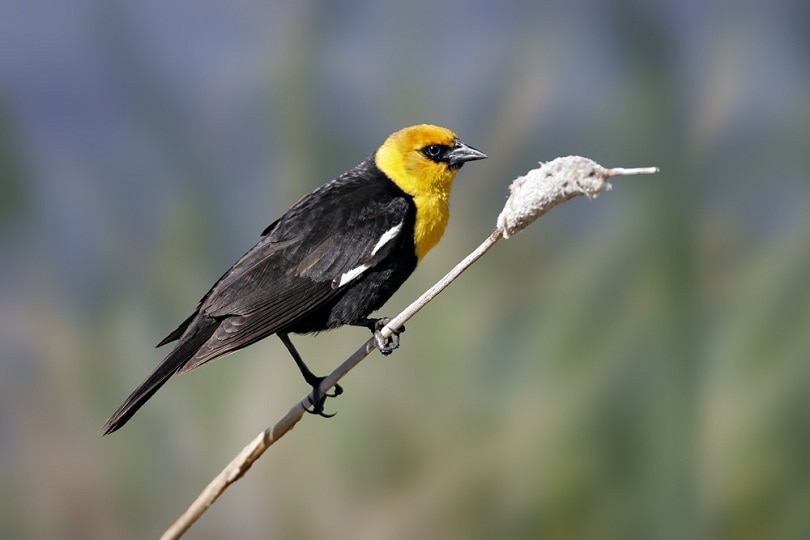
Canada is a large country with an extremely diverse number of terrestrial ecozones, everything from the Taiga Plains to the Atlantic Maritimes and the Prairies. All the natural diversity in the temperatures and landscapes leads to a large variety of birds.
Here, we cover the various black birds found in Canada. Not all of them are of the blackbird species, though, which is comprised of some birds that are black and others that are quite colourful. We hope that you’ll learn more about Canada’s not-so-ordinary black birds.

The 17 Types of Black Birds in Canada
1. Brewer’s Blackbird
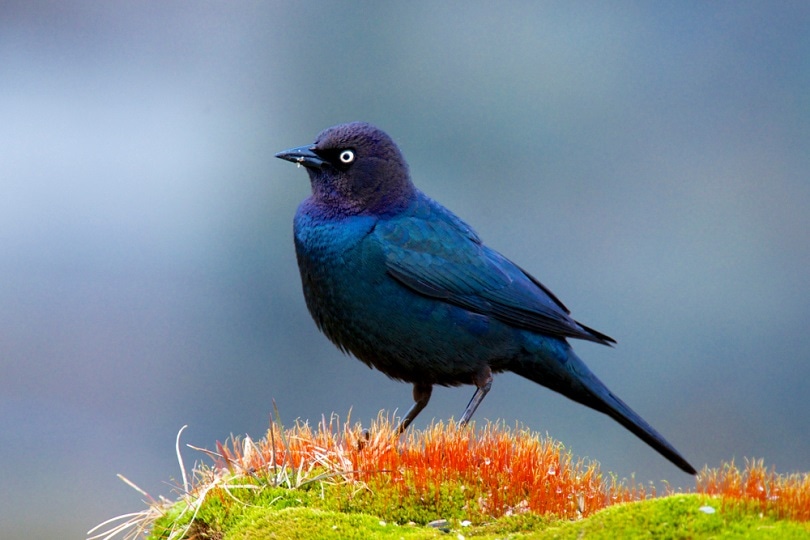
| Scientific name | Euphagus cyanocephalus |
| Distribution | East of the Great Lakes to Northern B.C., south to California, and east to northern Florida |
| Habitat | Diverse but mainly in marshes; otherwise, in city parks, fields, and riverbanks |
The Brewer’s Blackbird is one of the more common blackbirds in North America. The male has shiny, iridescent black plumage and yellow eyes, and the female has dark-coloured eyes and greyish-black plumage.
The Brewer’s Blackbird has two songs, both of which are quite short and not that musical. One of the songs has an almost metallic sound.
2. Red-Winged Blackbird
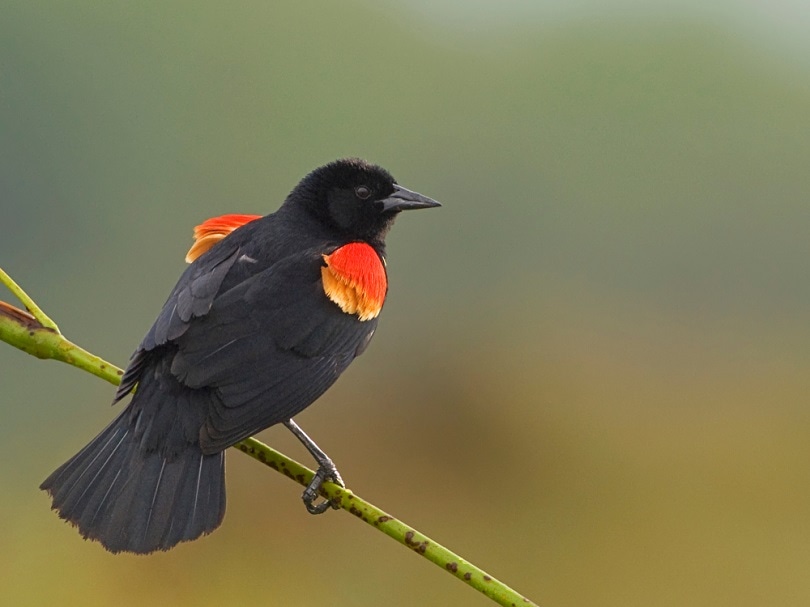
| Scientific name | Agelaius phoeniceus |
| Distribution | From northwestern B.C. and Alaska to the Yucatan peninsula and covering almost the entire North American continent. |
| Habitat | Primarily marshes and wetlands |
Red-winged blackbird males are unmistakable in appearance. The males are glossy black with red and yellow shoulder patches. The females are more of a streaked brown and can resemble a large sparrow.
Their song is also distinctive. It’s relatively short, but it starts with a note that ends with a musical trill.
3. Rusty Blackbird
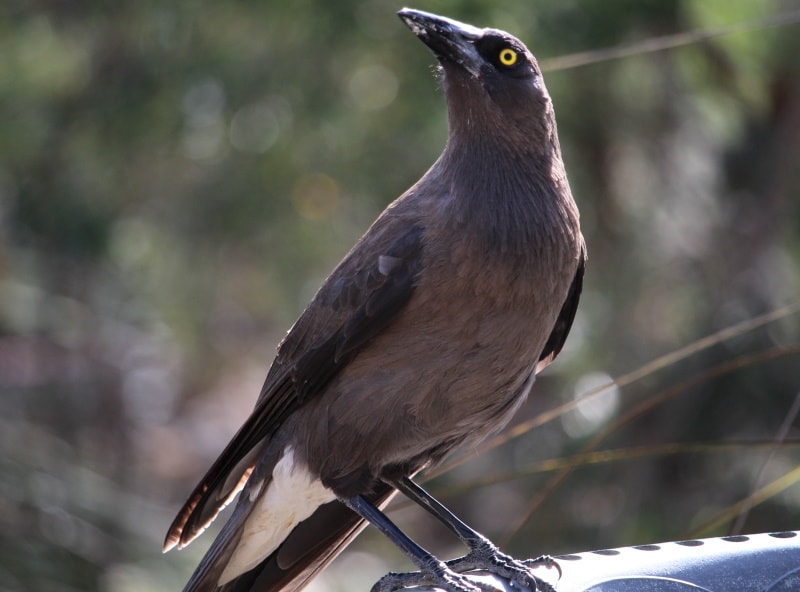
| Scientific name | Euphagus carolinus |
| Distribution | Nest in Alaska and Canada and winter in the eastern U.S. |
| Habitat | Boreal forests and wetlands |
The Rusty Blackbird male is glossy black with iridescent green during the breeding season and sports rust colours in the non-breeding season. Females are brown to rusty coloured, with pale eyes.
Their song is two to three notes followed by a rising note. It’s been compared to rusty hinges creaking. Unfortunately, there has been an 85% to 95% decline in the Rusty Blackbird population.
4. Yellow-Headed Blackbird
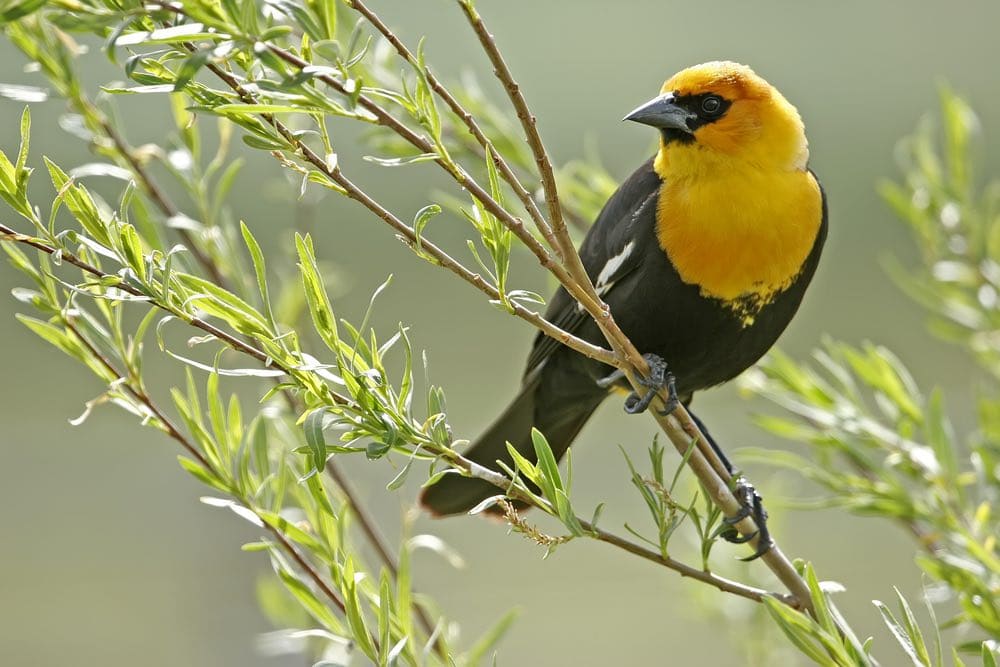
| Scientific name | Xanthocephalus xanthocephalus |
| Distribution | Canadian prairies into the central states of the U.S.; migration takes them to Mexico and the southern States |
| Habitat | Farm fields and freshwater wetlands |
The Yellow-Headed Blackbird is a little more colourful than the other black birds on this list. While the males have bright yellow heads that continue onto the breast, their bodies are black. Females are a brownish colour with a dull yellow breast and head.
The song is a couple of musical notes followed by a loud, almost buzzing sound. It’s quite distinctive once you’ve heard it.
5. Bobolink

| Scientific name | Dolichonyx oryzivorus |
| Distribution | Southern parts of Canada from B.C. to Newfoundland and Labrador; northwestern to northeastern U.S. |
| Habitat | Grassy fields and pastures |
The Bobolink is not all black. The males are black and white on top and solid black underneath, with a pale-yellow patch on the back of the head. Females are soft brown and yellow in colour.
Bobolinks sing with a bubbly and rambling song in a mixture of high- and low-pitched notes.
6. Lark Bunting

| Scientific name | Calamospiza melanocorys |
| Distribution | Southern Canadian prairies into central U.S. and northern Mexico |
| Habitat | Grasslands and shrub-steppe |
The Lark Bunting male is a large sparrow that is primarily black with a white patch along the wing. Females are mostly brown, with brown streaking on the breast.
The males have two songs with repeated notes that can be slow or rapid as trills. The slower song can last as long as 8 seconds.
7. Brown-Headed Cowbird
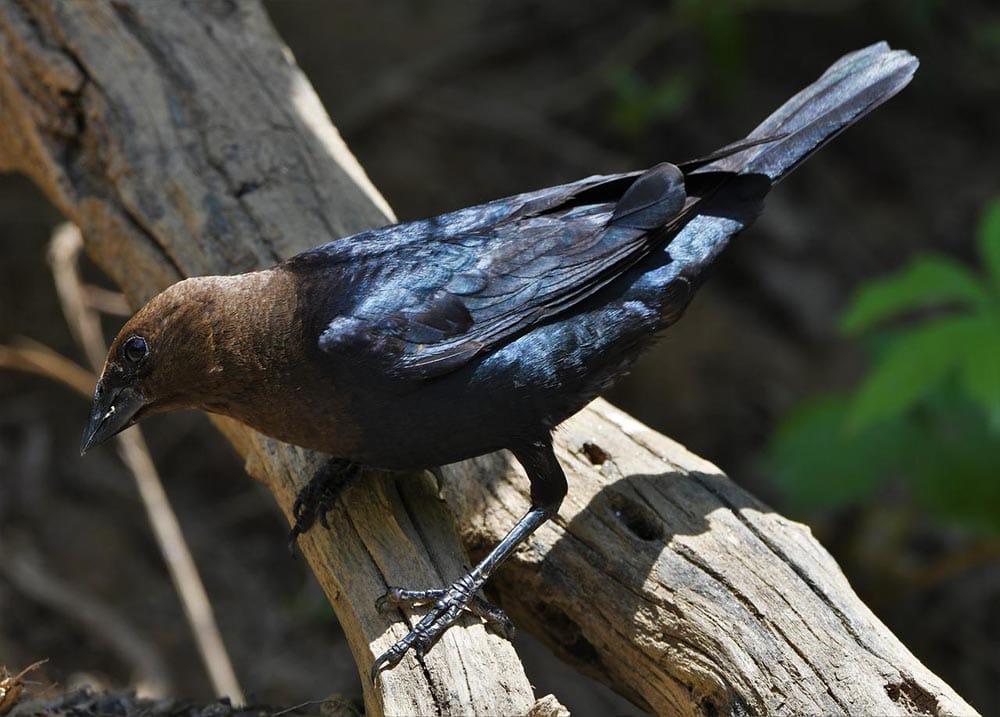
| Scientific name | Molothrus ater |
| Distribution | Southern Canada, Mexico, and most of the U.S. |
| Habitat | Fields, meadows, and lawns |
The Brown-Headed Cowbird males have black bodies and brown heads, and the females are all brown, which is lighter on their heads and underbellies.
Their song sounds like low gurgling notes followed by an almost sliding whistle. The females don’t nest but instead lay their eggs in other birds’ nests, forcing those birds to become foster parents, often at the expense of their own young.
8. Brandt’s Cormorant

| Scientific name | Urile penicillatus |
| Distribution | Along the west coast from Mexico to California up to B.C. |
| Habitat | Marine coastlines and estuaries |
The Brandt’s Cormorant isn’t quite the same as the other birds on this list. These are large birds with slender necks. They have black plumage with a purple sheen on their heads and a bright blue skin patch on their chins. They are excellent divers.
Definitely not songbirds, the Brandt’s Cormorant calls with low guttural growls and croaks.
9. Great Cormorant

| Scientific name | Phalacrocorax carbo |
| Distribution | Northeastern coastline from Newfoundland and Labrador down to New England |
| Habitat | Mainly saltwater areas, on rocky shorelines |
The Great Cormorant is a large waterbird with a long neck, a black body, and white patches on the throat and flanks.
They will call at the nest with guttural and purring sounds but remain relatively silent otherwise. While they are found in saltwater areas in North America, the Great Cormorant can primarily be found in freshwater lakes and rivers around the world.
10. Pelagic Cormorant

| Scientific name | Urile pelagicus |
| Distribution | Along the Pacific coast |
| Habitat | Marine coastline |
The Pelagic Cormorant is a slender waterbird and one of the smallest of the cormorants. They are all black with an iridescent green sheen to their feathers. The name “Pelagic” actually means “of the open ocean,” which isn’t entirely accurate because they stick close to land.
They are quiet birds for the most part except while breeding. Males make a kind of gargling and groaning call, and females make croaking and clicking sounds.
11. American Crow
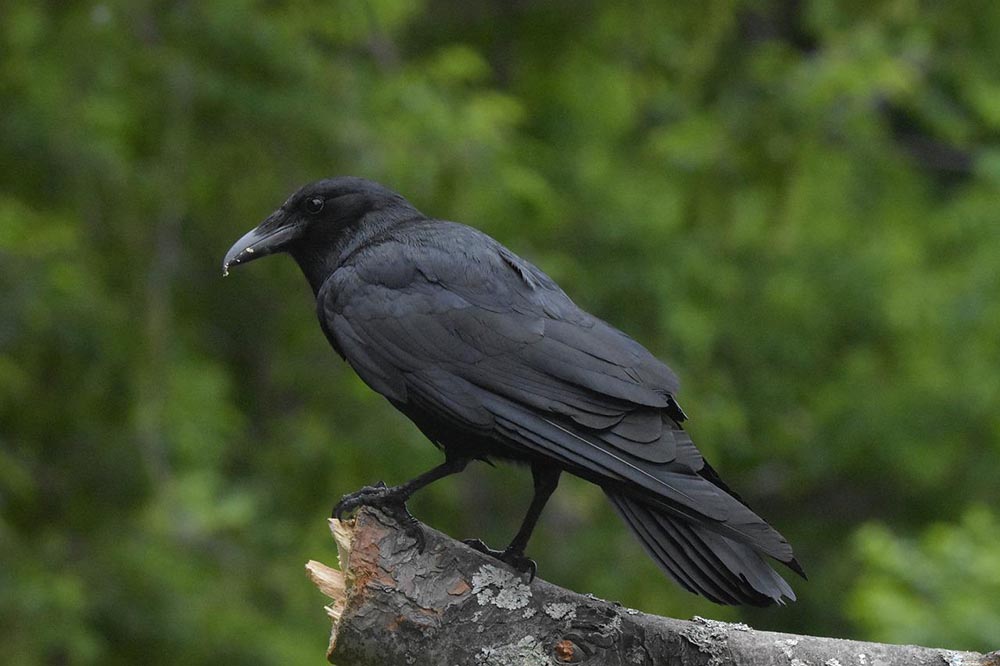
| Scientific name | Corvus brachyrhynchos |
| Distribution | Across Canada, the U.S., and northern Mexico |
| Habitat | Almost everywhere |
The American Crow almost needs no introduction if you reside in Canada. They are probably one of the first birds that you think of when black birds are brought up as a topic. They are solid black, beak and all, and are famous for their intelligence.
Crows caw, and it’s unmistakable when you hear it. They also make a multitude of other sounds, like rattles, clicks, and coos.
12. Northwestern Crow

| Scientific name | Corvus caurinus |
| Distribution | Northwestern coast from Washington State up to Alaska |
| Habitat | Almost anywhere along the coast |
The Northwestern Crow is similar in appearance to the American Crow, except they are slightly smaller. They are also all black with black beaks.
Their calls are quite similar but are lower and huskier. They are believed to be a subspecies of the American Crow, and in 2020, the American Ornithological Society announced that the Northwestern Crow would be officially absorbed into the American Crow.
13. Common Grackle
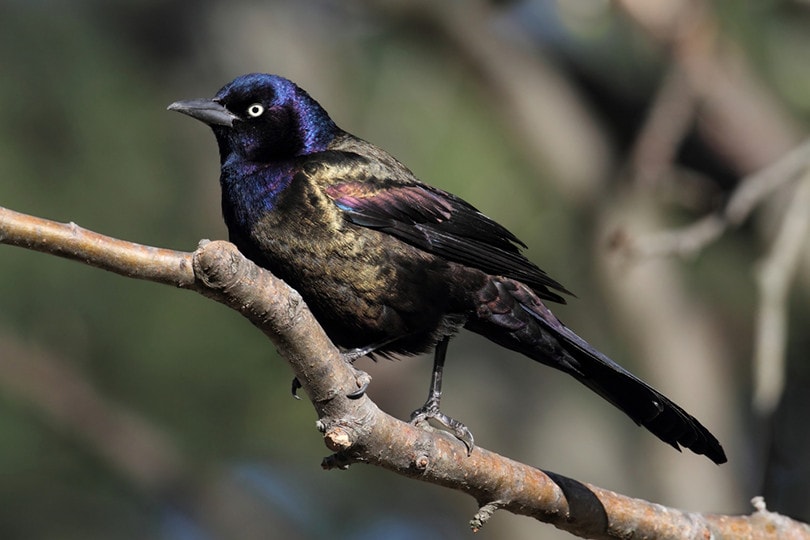
| Scientific name | Quiscalus quiscula |
| Distribution | Across North America east of the Rockies |
| Habitat | Marshes, open woodlands, fields, parks, suburbs |
The Common Grackle male is a dark bird with an iridescent blue head and bronze sheen over their body. Females are similar in appearance to the males but are not as glossy.
Grackles make several different high-pitched whistles and croaks. These are short at less than a second and are described as sounding like a rusty gate.
14. Black-Billed Magpie

| Scientific name | Pica hudsonia |
| Distribution | Western North America |
| Habitat | Almost everywhere |
Black-billed Magpies are quite striking. They are black and white, and the black feathers shine with a greenish-blue iridescence.
They are vocal birds with raspy chatter and a loud ascending call. They can be commonly seen sitting on road signs and fenceposts and are quite recognizable when they fly with a flash of white and trailing tail feathers.
15. Common Raven
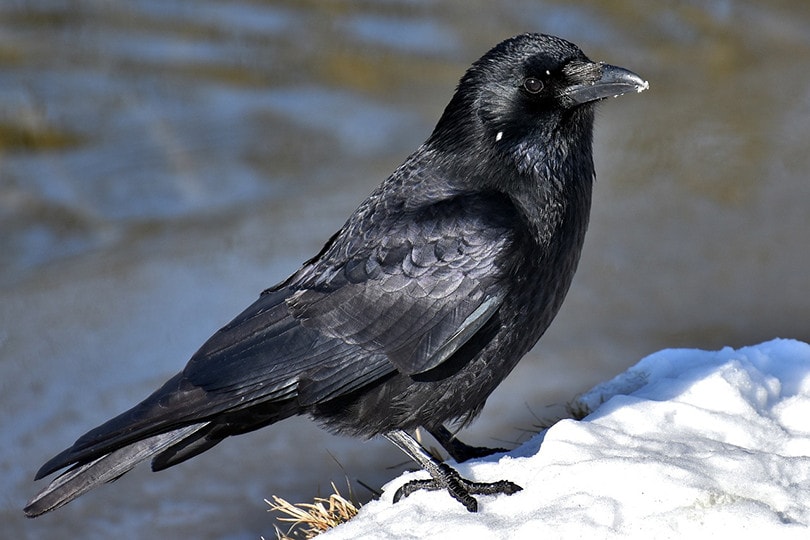
| Scientific name | Corvus corax |
| Distribution | Across the Northern Hemisphere |
| Habitat | Forests, national parks, foothill forests, outskirts of towns |
The Common Raven is a bird that almost needs no introduction. They have been written about in folklore and other stories and are intelligent birds. Like crows, they are all black but are much larger than all the other birds in the corvid family.
They, like crows, have a distinctive call but it’s more guttural. They have multiple vocalizations, as many as 33, but they are most known for the gurgling croak.
16. American Redstart

| Scientific name | Setophaga ruticilla |
| Distribution | Across Canada coast to coast and into the northern States |
| Habitat | Deciduous woodlands |
American Redstart males are primarily black with bright orange patches on their wings, tail, and sides. Females have a gray head, olive back, and yellow patches on their tail, wings, and sides.
They make a series of chirps that build and end on a down note. It’s been compared to the sound of someone sneezing.
17. Starling
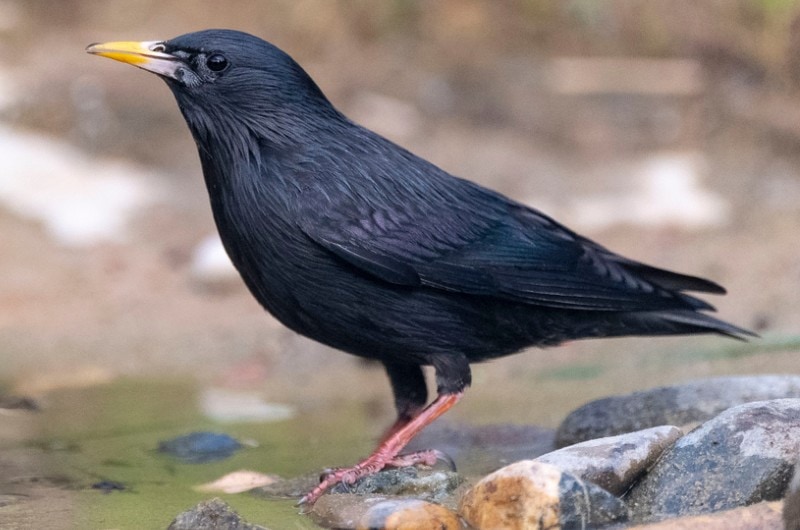
| Scientific name | Sturnus vulgaris |
| Distribution | Worldwide |
| Habitat | Cities and towns |
Starlings were originally called European Starlings because that’s where they originated. Over 100 birds were set loose in New York’s Central Park in the 1890s. Now, there are currently more than 200 million Starlings across North America. They are dark birds with a purplish-green sheen.
It’s difficult to describe the song of the Starling. They are related to Mynah birds, so they have the ability to mimic other sounds. They can imitate jays, hawks, and meadowlarks and can trill warble, chatter, whistle, etc.

Final Thoughts
There are plenty of other birds found throughout Canada that have a black colouration of some kind. But we hope that this list of predominantly black birds has shown you that black is far from boring!
All these birds have something to offer, whether it’s their beauty or their songs. We’re lucky indeed to have so many birds to enjoy in this breathtaking country of ours!
Featured Image Credit: Kenneth Rush, Shutterstock
Table of Contents
- The 17 Types of Black Birds in Canada
- 1. Brewer’s Blackbird
- 2. Red-Winged Blackbird
- 3. Rusty Blackbird
- 4. Yellow-Headed Blackbird
- 5. Bobolink
- 6. Lark Bunting
- 7. Brown-Headed Cowbird
- 8. Brandt’s Cormorant
- 9. Great Cormorant
- 10. Pelagic Cormorant
- 11. American Crow
- 12. Northwestern Crow
- 13. Common Grackle
- 14. Black-Billed Magpie
- 15. Common Raven
- 16. American Redstart
- 17. Starling
- Final Thoughts
About the Author Kathryn Copeland
Kathryn was a librarian in a previous lifetime and is currently a writer about all things birds. When she was a child, thanks to her love of animals she hoped to work in zoos or with wildlife in some way. She's not strong in the sciences, unfortunately, so she uses her time to research and write about all kinds of birds and animals, and hopes to bring that detailed knowledge to OpticsMag.
Related Articles:
Monocular vs Telescope: Differences Explained (With Pictures)
10 Types of Hummingbirds in Arkansas (With Pictures)
8 Types of Hummingbirds in Nebraska (With Pictures)
5 Types of Hummingbirds in Idaho (With Pictures)
3 Types of Hummingbirds in Mississippi (With Pictures)
8 Types of Hummingbirds in Kansas (With Pictures)
5 Types of Hummingbirds in West Virginia (With Pictures)
5 Types of Hummingbirds in Ohio (With Pictures)
